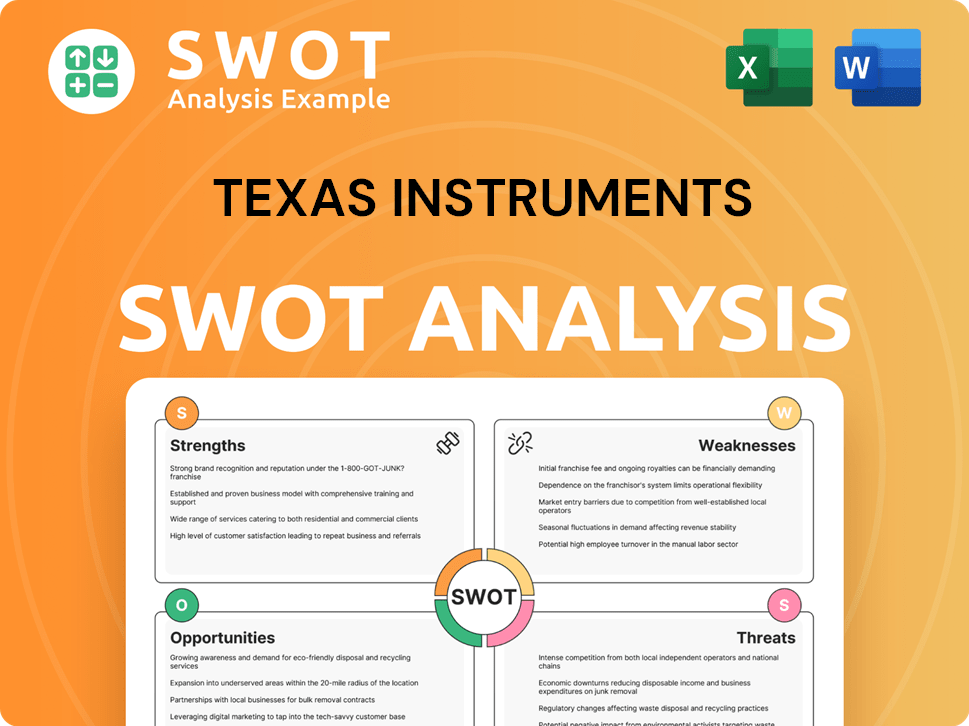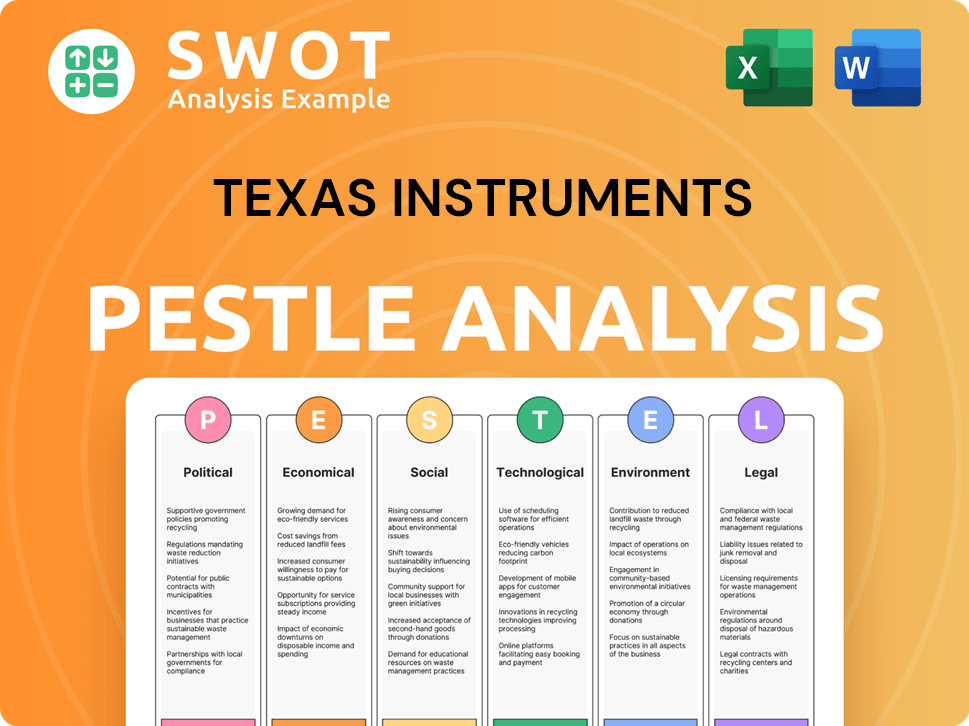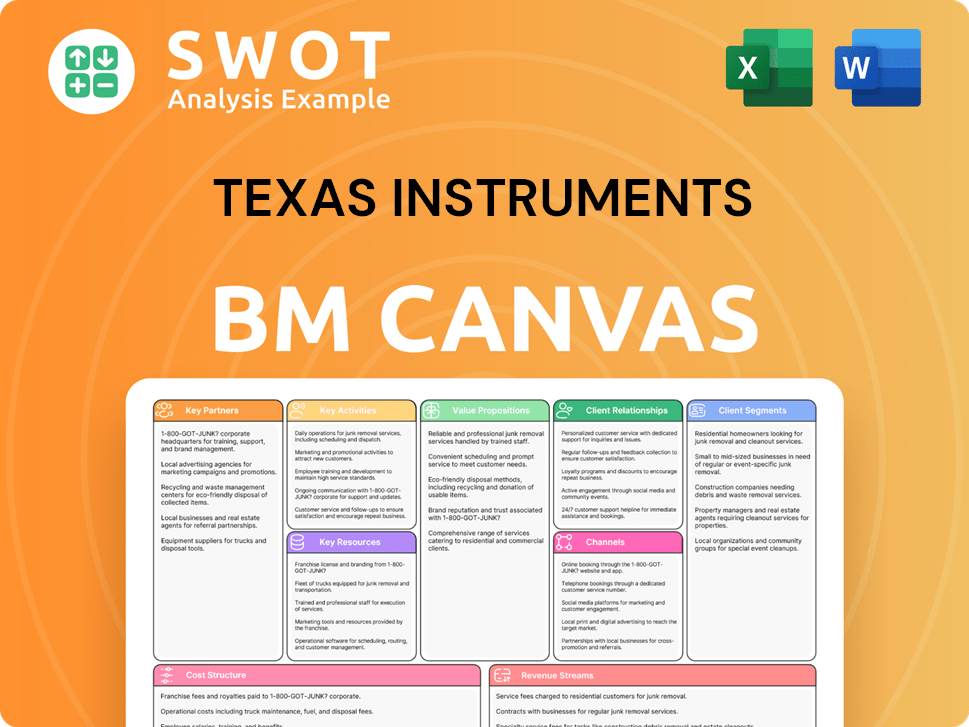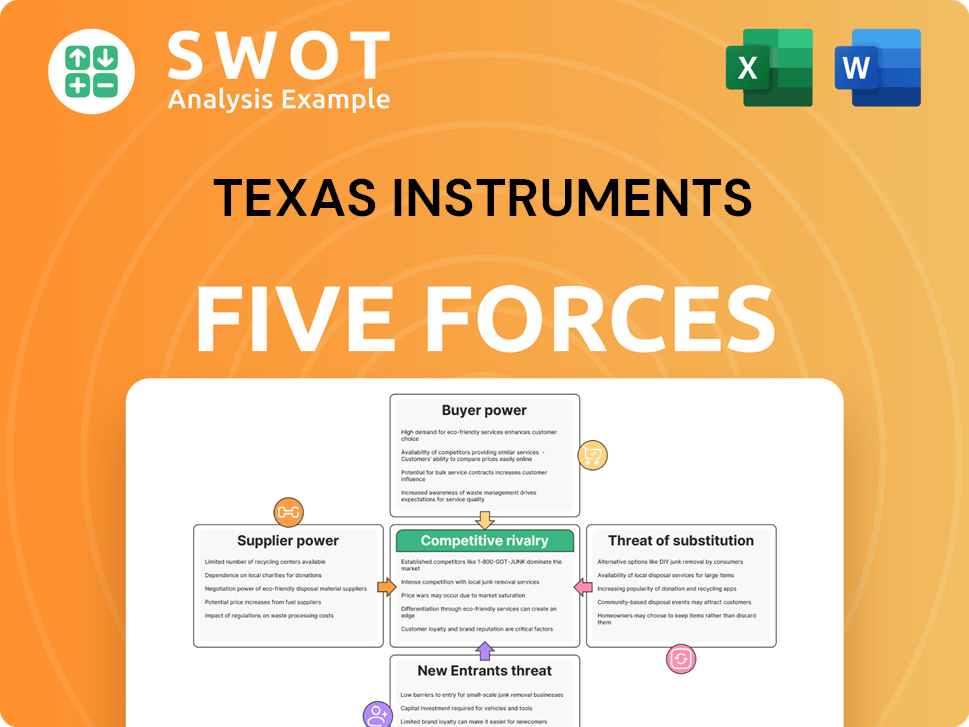Texas Instruments Bundle
Who Buys from Texas Instruments?
Understanding the customer base is critical for any company's success, especially in the fast-paced semiconductor industry. For Texas Instruments SWOT Analysis, a global leader, knowing its customer demographics and target market is key to navigating market cycles and identifying growth opportunities. Founded in 1930, TI has evolved, now focusing on analog and embedded processing solutions.

This strategic shift significantly shaped its customer base. In 2024, the industrial and automotive markets generated approximately 70% of TI's revenue, highlighting a deliberate focus on these high-growth sectors. This focus allows TI to capitalize on the increasing semiconductor content within these industries, requiring a deep dive into who the TI customers are. This analysis will explore the company's market segmentation, the needs of its TI audience, and where its customer base is located, providing insights into its customer acquisition strategies.
Who Are Texas Instruments’s Main Customers?
Understanding the customer demographics and target market is crucial for any company, and for Texas Instruments, this involves a deep dive into its business-to-business (B2B) operations. The company, a major player in the semiconductor industry, focuses on selling its products to other businesses that incorporate these components into their own products. This strategic approach allows it to concentrate on specific sectors and tailor its offerings to meet the unique demands of each.
Texas Instruments serves a broad customer base, which includes over 100,000 customers globally. This wide reach is a key aspect of its business model, ensuring that it isn't overly reliant on any single client. This diversification strategy is evident in its revenue distribution, with no single customer accounting for more than 10% of its total revenue. This approach helps to mitigate risks and maintain stability in a dynamic market.
The company's main customer groups are categorized by industry, with the industrial and automotive sectors representing the largest share of revenue. In 2024, the industrial market accounted for 34% of TI's revenue, while the automotive market comprised 35%, collectively making up about 70% of the total revenue. Other significant segments include personal electronics (20%), enterprise systems (5%), and communication equipment (4%).
Texas Instruments' market segmentation strategy focuses on identifying and serving specific industries that require its semiconductor products. This approach allows the company to tailor its products and services to meet the unique needs of each sector. The company's primary target markets include industrial, automotive, personal electronics, enterprise systems, and communication equipment.
The main customer groups for Texas Instruments are electronics designers and manufacturers. These customers use TI's semiconductors and integrated circuits in their products. The company's diverse customer base includes businesses in the industrial, automotive, personal electronics, enterprise systems, and communication equipment sectors, highlighting its broad market reach.
The revenue distribution across different sectors shows TI's strategic focus and market priorities. The industrial and automotive markets are the largest contributors, reflecting the company's investment in these high-growth areas. While overall revenue declined in 2024 to $15.64 billion, the company anticipates a return to growth in 2025, driven by strong performance in its core segments.
Texas Instruments' strategic focus on the industrial and automotive markets is driven by the belief that these sectors offer the best growth opportunities due to increasing semiconductor content. This strategic direction is supported by investments in these core segments. For more insights into the company's overall strategy, consider reading about the Growth Strategy of Texas Instruments.
Texas Instruments' customer demographics are characterized by its B2B model, serving a diverse range of industries. The company's focus on industrial and automotive sectors, which constitute the majority of its revenue, indicates a strategic allocation of resources and a keen understanding of market trends.
- The industrial and automotive sectors are the primary drivers of revenue, reflecting the company's strategic focus.
- A diverse customer base of over 100,000 clients ensures that the company is not overly dependent on any single customer.
- The company anticipates a return to growth in 2025, driven by its strategic investments in core segments.
- The personal electronics sector accounts for a significant portion of revenue, demonstrating the breadth of TI's market presence.
Texas Instruments SWOT Analysis
- Complete SWOT Breakdown
- Fully Customizable
- Editable in Excel & Word
- Professional Formatting
- Investor-Ready Format

What Do Texas Instruments’s Customers Want?
Understanding the needs and preferences of Texas Instruments' (TI) customers is crucial for its success. The company primarily serves businesses, and its customer base is driven by specific requirements related to semiconductor solutions. These needs shape how TI develops and markets its products, influencing its strategies for customer engagement and market segmentation.
TI's focus on analog and embedded processing products directly addresses critical customer needs. These products are essential for power management, signal processing, and control systems across a wide range of applications. Customers seek solutions that offer both high performance and cost-effectiveness, alongside the assurance of long lifecycles and dependable supply.
The company's approach is tailored to meet these demands, emphasizing internal manufacturing capabilities and strategic investments. This in-house manufacturing provides lower costs and greater supply chain control, which is a significant preference for customers seeking geopolitical dependability. TI's ability to meet these needs is central to its ability to maintain and grow its customer base.
TI customers, which include a broad range of businesses, have specific needs that influence their purchasing behavior. These needs are often tied to long design cycles and high switching costs, particularly in the embedded processing segment. TI addresses these pain points by continuously investing in research and development.
- Reliable and High-Performance Solutions: Customers require semiconductors that deliver consistent performance and reliability.
- Cost-Effective Products: Competitive pricing is a key factor, with customers seeking solutions that offer value.
- Long Lifecycles and Dependable Supply: Customers need products with extended lifespans and assured availability.
- Geopolitical Dependability: In-house manufacturing and supply chain control are essential for mitigating risks.
- Broad Product Portfolio: A wide range of products allows customers to find solutions for diverse applications.
Texas Instruments PESTLE Analysis
- Covers All 6 PESTLE Categories
- No Research Needed – Save Hours of Work
- Built by Experts, Trusted by Consultants
- Instant Download, Ready to Use
- 100% Editable, Fully Customizable

Where does Texas Instruments operate?
The geographical market presence of Texas Instruments (TI) is extensive, with operations spanning over 30 countries. This global footprint is crucial for serving its diverse customer base and maintaining a competitive edge in the semiconductor industry. TI's strategic approach to market distribution and manufacturing allows it to cater to regional demands effectively.
In 2024, the United States was the largest market for TI, contributing significantly to its revenue. Other key regions, including EMEA, China, and Japan, also played vital roles in the company's financial performance. TI's ability to adapt to regional market dynamics is a key factor in its sustained success.
TI's revenue distribution across different geographical regions highlights its key markets and strategic focus. The company's direct sales channels, including TI.com, are essential for reaching its customers and accounted for approximately 80% of its revenue in 2024. Furthermore, TI is expanding its manufacturing capacity globally to meet customer demand and ensure a reliable supply chain.
In fiscal year 2024, the United States generated $5.96 billion in revenue for TI, representing 38.09% of its total revenue. The U.S. also experienced the highest growth, with a 2.46% increase compared to 2023, demonstrating the importance of the domestic market. The substantial revenue from the U.S. market indicates a strong customer base and effective market penetration.
Other significant markets in 2024 included EMEA with $3.52 billion (22.5% of total revenue), China with $3.01 billion (19.26%), Rest of Asia with $1.68 billion (10.75%), and Japan with $1.21 billion (7.75%). These regions contribute substantially to TI's global revenue, highlighting the company's diverse customer base and market reach. Understanding the market segmentation is crucial for TI's strategic planning.
In Q1 2025, while EMEA saw a 2% decline and Japan experienced a 17% decline, the U.S. led growth with an 18% year-over-year increase to $1.52 billion. China also showed strong growth, up 33% year-over-year to $826 million. These figures reflect the dynamic nature of the global market and the importance of adapting to regional changes. For more insights, check out the Marketing Strategy of Texas Instruments.
TI's direct sales channels accounted for approximately 80% of its revenue in 2024, including sales through TI.com. The company is also expanding its internal manufacturing capacity globally, with ongoing construction of 300mm wafer fabs in Texas and Utah. This expansion supports TI's customer acquisition strategies and ensures a dependable supply chain.
Texas Instruments Business Model Canvas
- Complete 9-Block Business Model Canvas
- Effortlessly Communicate Your Business Strategy
- Investor-Ready BMC Format
- 100% Editable and Customizable
- Clear and Structured Layout

How Does Texas Instruments Win & Keep Customers?
The company, known for its semiconductor solutions, employs a sophisticated strategy to acquire and retain customers. Their approach centers on direct engagement and a comprehensive product portfolio. This strategy is designed to build strong, lasting relationships with their TI customers and maintain a competitive edge in the market.
A key element of their customer acquisition strategy involves fostering direct relationships. The company has significantly increased its direct sales channels, which now account for a substantial portion of its revenue. This direct interaction provides them with valuable insights into their TI audience's needs and design projects, allowing for tailored solutions and better market penetration.
The company's retention strategy is built on several pillars, including a vast product range and continuous innovation. They offer over 80,000 analog and embedded processing products and consistently introduce new products, ensuring they meet the evolving needs of their diverse customer base. This approach, combined with a commitment to supply chain reliability, strengthens customer loyalty and reduces switching costs.
The company prioritizes direct interactions with its customers. In 2024, approximately 80% of its revenue came from direct transactions, a significant increase from about a third in 2019. This includes sales through their website and a dedicated sales and marketing team.
Their retention strategy hinges on an expansive product line. The company offers over 80,000 analog and embedded processing products. They continuously invest in R&D, introducing hundreds of new products each year.
The company ensures a reliable supply chain through internal manufacturing. This approach helps to lower costs and provides greater control over the supply, which is crucial for customer satisfaction. They focus on providing excellent customer service.
The company benefits from long product cycles, especially in segments like analog, which typically last 10-15 years. This longevity contributes to high customer retention rates because it reduces the need for frequent redesigns or replacements.
The company focuses on providing excellent customer service and delivering high-quality products to maintain customer satisfaction and loyalty. Their commitment to a consistent dividend policy, with 21 consecutive years of increases, also plays a role in attracting and retaining investors.
- Customer-Centric Initiatives: The company invests in customer-centric initiatives to strengthen relationships.
- Dividend: The dividend policy supports the company's ability to invest in customer-centric initiatives.
- Market Share: Greater access to customers and deeper insights into their design projects, ultimately leading to opportunities for increased market share.
- Commitment: TI's commitment to its dividend, with 21 consecutive years of increases, also plays a role in attracting and retaining investors.
Texas Instruments Porter's Five Forces Analysis
- Covers All 5 Competitive Forces in Detail
- Structured for Consultants, Students, and Founders
- 100% Editable in Microsoft Word & Excel
- Instant Digital Download – Use Immediately
- Compatible with Mac & PC – Fully Unlocked

Related Blogs
- What are Mission Vision & Core Values of Texas Instruments Company?
- What is Competitive Landscape of Texas Instruments Company?
- What is Growth Strategy and Future Prospects of Texas Instruments Company?
- How Does Texas Instruments Company Work?
- What is Sales and Marketing Strategy of Texas Instruments Company?
- What is Brief History of Texas Instruments Company?
- Who Owns Texas Instruments Company?
Disclaimer
All information, articles, and product details provided on this website are for general informational and educational purposes only. We do not claim any ownership over, nor do we intend to infringe upon, any trademarks, copyrights, logos, brand names, or other intellectual property mentioned or depicted on this site. Such intellectual property remains the property of its respective owners, and any references here are made solely for identification or informational purposes, without implying any affiliation, endorsement, or partnership.
We make no representations or warranties, express or implied, regarding the accuracy, completeness, or suitability of any content or products presented. Nothing on this website should be construed as legal, tax, investment, financial, medical, or other professional advice. In addition, no part of this site—including articles or product references—constitutes a solicitation, recommendation, endorsement, advertisement, or offer to buy or sell any securities, franchises, or other financial instruments, particularly in jurisdictions where such activity would be unlawful.
All content is of a general nature and may not address the specific circumstances of any individual or entity. It is not a substitute for professional advice or services. Any actions you take based on the information provided here are strictly at your own risk. You accept full responsibility for any decisions or outcomes arising from your use of this website and agree to release us from any liability in connection with your use of, or reliance upon, the content or products found herein.